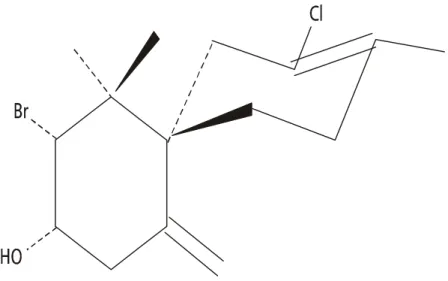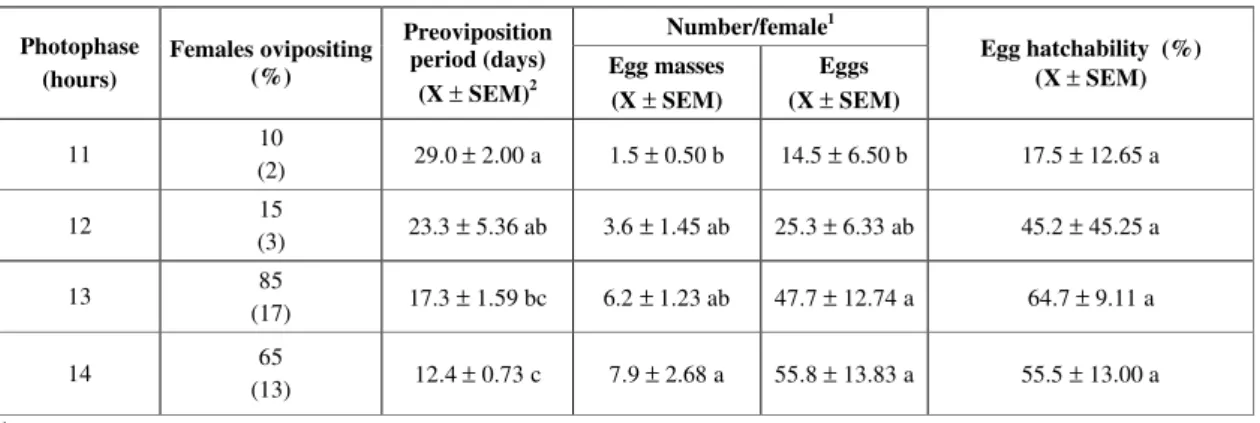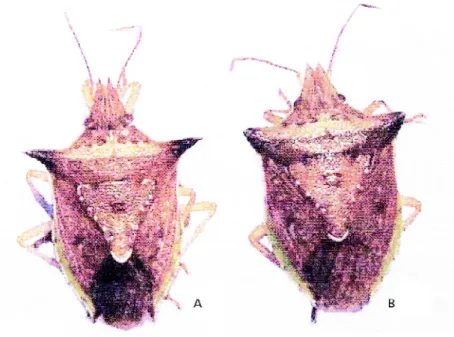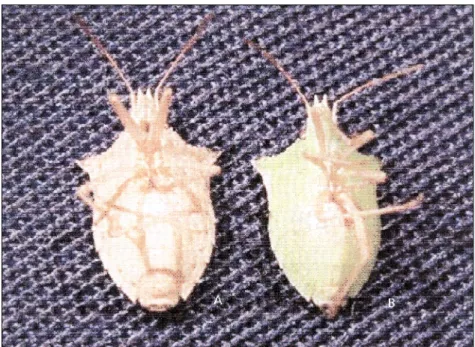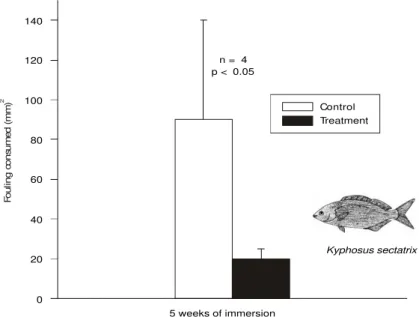PHOTOPERIOD INFLUENCE ON THE
BIOLOGY AND PHENOLOGICAL CHARACTERISTICS
OF
Dichelops melacanthus
(DALLAS, 1851)
(HETEROPTERA: PENTATOMIDAE)
CHOCOROSQUI, V. R.1 and PANIZZI, A. R.2
1Departamento de Zoologia, Universidade Federal do Paraná, C.P. 19020, Curitiba, Paraná, Brazil 2Embrapa Labex, NCAUR/ARS/USDA, Peoria, IL 61604, USA
Correspondence to: Antônio R. Panizzi, Embrapa-Labex, NCAUR/ARS/USDA, Peoria, IL 61604, USA, e-mail: panizzia@ncaur.usda.gov
Received August 27, 2002 – Accepted November 22, 2002 – Distributed November 30, 2003 (With 6 figures)
ABSTRACT
The influence of the photoperiod on the biology and seasonal morphs of Dichelops melacanthus (Dallas,
1851) was studied in the laboratory. Four different photoperiods (11, 12, 13, and 14 hL = hours of light) were tested, keeping the temperature at 25 ± 1oC and the relative humidity at 65 ± 5%. Nymph
develop-mental time tended to be longer under shorter photophases (11 and 12 hL). The 14-hour photophase (long day) resulted in lower nymph mortality rates. Females maintained at 13 and 14 hL showed greater weight gain (1st-28th day) than females under 12 hL. D. melacanthus showed reproductive oligopause induced by
short photophases, especially when exposed to 11 hL. Under 13 and 14 hL, 85% and 65% of females ovi-posited, respectively, in comparison to 10% and 15% of females ovipositing under 11 and 12 hL, respectively. Fecundity (number of egg masses and number of eggs/female) was greater in the longer than under the shorter photophases. Seasonal dimorphism induced by photoperiod was observed in D. melacanthus adults.
Under short-day conditions (11 and 12 hL), adults showed short and rounded shoulder spines, grayish brown abdomen (mainly in 11 hL), high lipid contents, and lower percentage of mature reproductive organs. Under long-day conditions (13 and 14 hL), the stink bugs showed greatly developed shoulder spines, green ab-domen, low lipid contents, and mature reproductive organs.
Key words:diapause, development, reproductive performance, dimorphism, photophase.
RESUMO
Influência do fotoperíodo na biologia e nas características fenológicas de Dichelops
melacanthus (Dallas, 1851) (Heteroptera: Pentatomidae)
A influência do fotoperíodo na biologia e nas formas sazonais de Dichelops melacanthus (Dallas, 1851)
foi estudada em laboratório. Foram utilizadas quatro condições fotoperiódicas diferentes (11, 12, 13 e 14 hL = horas de luz), mantendo a temperatura a 25 ± 1oC e a umidade relativa a 65 ± 5%. O tempo
de desenvolvimento das ninfas tendeu a ser mais longo nas fotofases mais curtas (11 e 12 hL). A fotofase de 14 horas (dia longo) foi a melhor condição para o desenvolvimento ninfal, apresentando baixos índices de mortalidade durante esse período. Fêmeas mantidas sob 13 e 14 hL apresentaram maior ganho de peso (1o-28o dia) do que fêmeas sob 12 hL. D. melacanthus apresentou oligopausa reprodutiva
INTRODUCTION
The photoperiod is an abiotic factor that influences insect biology and behavior, and can be considered the main factor regulating diapause (Ali & Ewiess, 1977). Diapause is the reduction or pause of insect metabolic activities during an unfavorable period and involves physiological, epidemical, biochemical, and behavioral changes (Leather et al.,
1993).
Studies that associate photoperiod and diapause have been conducted with several species of penta-tomids. Albuquerque (1993) observed in the laboratory that Oebalus poecilus (Dallas) is induced to diapause
by short days. Adults of Aelia fieberi (Scott) are induced
to diapause under short photoperiods, and long days promote reproduction (Nakamura & Numata, 1997). Mourão & Panizzi (2002) observed that Euschistus heros (Fabr.) presents reproductive diapause, which
is induced by a 12-hour (or less) photophase. Usually, diapausant insects have immature reproductive organs and high lipid contents, associated with a feeding pause (Kiritani, 1963).
Another dormancy type, the oligopause, is common among insects living in climates with moderate winters. Insects in oligopause periodically feed during the dormancy period, even with lipid accumulation during the preparatory period (Leather
et al., 1993).
According to McPherson (1974), photoperiod causes phenological changes in pentatomids, such as different seasonal morphs. For example, E. heros
showed short and rounded shoulder spines when maintained under short photophases during nymphal stage (Mourão & Panizzi, 2002).
Stink bugs of the genus Dichelops (Diceraeus)
are important soybean pests and have recently been associated with corn and wheat, causing heavy damage to young plants cultivated under the no-tillage system (Panizzi & Chocorosqui, 2000). These bugs, which were collected in southern Brazil during a one-year period, showed different seasonal morphs (Chocorosqui & Panizzi, unpublished). In Rio Grande do Sul State, this pentatomid shows behavior
similar to that of E. heros during autumn and winter.
The insects were inactive, usually sheltered under crop residues, with abdomens turned upward. The abiotic and biotic factors involved in insect seasonality need to be understood in order to develop better control methods for integrated pest management programs.
This study was carried out to evaluate photoperiod influence on nymph development, and also on adult longevity, weight gain, reproductive performance, and phenological changes of Dichelops melacanthus (Dallas) in the laboratory.
MATERIAL AND METHODS
Nymph biology
Adults of D. melacanthus were collected in
1999 at the Embrapa Soybean Farm, in Londrina, PR (latitude 23°55’46”S) and placed in a gerbox (11.0 x 11.0 x 3.5 cm) to obtain eggs. They were fed green pods and dry soybean seeds [Glycine max
(L.) Merrill] variety ‘Paraná’, and maintained at 25 ± 1°C, 65 ± 5% RH, and 14-hour photophase. Egg masses were mixed to avoid a genetic effect. Eggs were conditioned in Petri dishes (9.0 x 1.5 cm) lined with moistened filter paper and maintained in four different photophases: 11 hours of light (11 hL), 12 hL, 13 hL, and 14 hL. Temperature and relative humidity were kept constant (25 ± 1°C and 65 ±
5%, respectively).
During the 1st instar, nymphs were maintained only with distilled water. On the first day of the 2nd instar, 30 nymphs from each photophase were individualized in Petri dishes (9.0 x 1.5 cm) lined with filter paper. They were fed with green pods and dry soybean seeds, and supplied daily with distilled water. The same photoperiod used for the egg stage was maintained throughout nymphal development. Instar changes and mortality were observed daily.
Upon emergence, adults were separated by sex and weight on an electronic scale (Mettler Toledo PB 303). Instar duration, developmental time, and nymph mortality were calculated for nymphs under espinhos pronotais curtos e arredondados, abdômen marrom-acinzentado (principalmente em 11 hL), teor lipídico alto e baixa porcentagem de órgãos reprodutivos maduros. Sob condições de dias longos (13 e 14 hL), os percevejos apresentaram espinhos pronotais mais desenvolvidos e pontiagudos, abdômen verde, teor lipídico baixo e órgãos reprodutivos desenvolvidos.
each photoperiod. Treatments were set up in a completely randomized design, with the number of nymphs (n = 30) considered replicates. Data were submitted to analysis of variance, and means compared using Tukey’s test (p ≤ 0.05).
Adult biology
Egg masses were obtained as described above. Eggs from different egg masses were mixed and divided into four groups, which were conditioned in Petri dishes (9.0 x 1.5 cm) lined with moistened filter paper, and maintained under four different photophases: 11 hL, 12 hL, 13 hL, and 14 hL. Temperature and relative humidity were kept constant (25 ± 1°C and 65 ± 5%, respectively).
Groups of ten 2nd instar nymphs were placed in a gerbox (11.0 x 11.0 x 3.5 cm) lined with filter paper and fed with green pods and dry soybean seeds. Nymphs were reared under the same photoperiod as that of the egg stage. Food was renewed every other day and humidity was maintained by using moistened cotton in a plastic container (3.0 cm diameter). At adult emergence, 20 couples were formed for each photoperiod. Each couple was conditioned in a gerbox and fed with the same food offered to the nymphs. They were supplied daily with distilled water and food was renewed every other day.
Fresh body weights of females and males were taken on the 1st, 7th, 14th, 21st, and 28th days of adult
life. The weight gain between two evaluations was calculated by subtracting the last weighing from the previous one. The total weight gain was obtained by subtracting the weight on day 28 from the weight on day 1. The insects were observed periodically to verify feeding occurrence in each photoperiod. The reproductive activity was evaluated through the following parameters: percentage of ovipositing females, preoviposition period, number of egg masses/ female, number of eggs/female, and egg viability.
Longevity and survival of males and females were also evaluated in the several photophases. Treatments were set up in a completely randomized design, and the number of couples (n = 20) considered replicates. Data were submitted to analysis of variance, and means were compared using Tukey’s test (p ≤ 0.05).
Seasonal morphs and lipid contents
Egg masses of D. melacanthus obtained in the
laboratory were mixed to eliminate the genetic effect. Four groups of eggs (n = 50) were conditioned under
different photophases: 11 hL, 12 hL, 13 hL, and 14 hL, with constant temperature and relative humidity (25 ±
1°C and 65 ± 5%, respectively). Nymphs were conditioned and fed in the same way as nymphs reared for adult biology. Abdomen coloration of one-day-old adults (n = 20) was evaluated.
Adults were maintained, under the same conditions described above, for 20 days, time enough to reach sexual maturity under ideal conditions. After that, adults were killed by freezing to evaluate the following parameters: right shoulder spine length, shoulder spine shape (short, long, rounded, or pointed) and abdomen coloration. The shape of the shoulder spine was evaluated based only on its morphological aspect. Afterwards, the adults were divided into two groups (n = 10 each). In the first one, lipid content was measured using the following method: 1. insects were taken to the oven (60°C) for about 48 hours; 2. dry weight (DW) was obtained using an electronic scale (Mettler Toledo PB 303); 3. insects were identified with a number and individualized in cloth packages (3.0 x 4.0 cm); 4. packages were conditioned in extraction tubes (7.5 x 3.0 cm); 5. 250 ml of the extraction solvent (hexane) was added to a volumetric balloon and placed in the Soxhlet extractor, with circulation water and tubes; 6. equipment was heated up to ca. 120°C. After the first cycle, the extraction process was maintained for three hours; 7. adults were placed again in the oven (60°C) for 24 hours; 8. weight without lipid (“thin weight” = TW) was obtained, and the following formula was applied to obtain percentage (%) of stored lipid:
Treatments were set up in a completely randomized design, with replicates (n) as stated above. Data were submitted to analysis of va-riance, and means compared using Tukey’s test (p ≤ 0.05).
RESULTS AND DISCUSSION
Nymph biology
Photoperiod influenced mortality of D. melacanthus nymphs. During the 2nd instar, mortality
tended to be greater at 11 hL (46.7%) (Fig. 1). However, it dropped during the 3rd instar, and no nymphs died
during the 4th and 5th instars under 11 hL. Total nymph
mortality (instars 2-5) in this photophase was 53.4%. In the other photophases, nymph mortality ranged from 10.0 (12 and 13 hL) to 16.7% (14 hL) during the 2nd
instar. Nymphs reared under 12 hL showed greater mortality during the 5th instar, reaching 43.4%. Under
13 hL, mortality was 30.0% and 50.0% during the 3rd
and 4th instar, respectively. Total nymph mortality was
the same as for 11 hL of photophase (53.4%). Under 14 hL, only 30.0% of D. melacanthus nymphs did not
complete development. Mourão & Panizzi (2000b)
working with another species of pentatomid, E. heros,
also observed greater mortality of those under short photoperiod (56.7%), in comparison to nymphs under 14 hL (28.3%).
Nymphs tended to complete development faster under longer photoperiods. The 2nd instar lasted
longer at 11, 12, and 13 hL, in comparison to 14 hL (Table 1). In the 3rd instar, nymphs tended to develop
faster at 14 hL. During the 4th and 5th stadia, the
developmental time was longer at 12 hL than at 13 and 14 hL. There was also a significant difference in 5th instar duration between nymphs reared at 14 hL
(5.9 days) and 11 hL (8.6 days).
For males, total developmental time (instars 2-5) was shorter under 14 hL, in comparison to the other photoperiods. For females, there was a significant difference only between 14 hL (17.4 days) and the shortest photophases (11 and 12 hL). These results are supported by Mourão & Panizzi (2000b), who reported longer developmental time for E. heros
nymphs under short photoperiod (10 hL), than that under 14 hL. The fresh body weight of males and females of D. melacanthus did not differ statistically
among treatments.
Fig. 1 — Mortality (%) of Dichelops melacanthus nymphs reared under different photoperiods, feeding on green pods and dry
Adult biology
Weight gain of males and females of D. melacanthus occurred mostly during the first days
of adult life, up to day 14 (Fig. 2). In spite of the tendency to greater weight gain under 13 and 14 hL until day 7, there was no significant difference in weight gain/week among all the photophases, during the 4-week evaluation period. A significant difference was detected in the total weight gain of females (days 1-28). Females maintained in 13 and 14 hL (summer photophases in southern Brazil) showed greater weight gain than females at 12 hL. In the former photophases, nutrient intake may have been greater. However, this tendency to greater food intake in longer photophases did not occur with females at 11 hL, which gained weight similary to those under 13 and 14 hL. Obviously, further studies are needed to clarify this point. Adults in all photophases were observed to feed continuously, showing that this activity was not affected by reduced photoperiod. Reproductive performance of females also varied with the different photoperiods tested (Table 2): 85% and 65% of the females oviposited at 13 and 14 hL, respectively, but under 11 and 12 hL, only 10% and 15% of females oviposited, respectively. Preoviposition period was longer for females maintained under 11 and 12 hL, in comparison to females at 14 hL. For females under 13 and 14 hL, fecundity (number of egg masses and number of eggs) was greater than that of females under 11 and 12 hL (local winter photophases); egg hatchability, however, only tended to be higher in longer photophases. Mourão & Panizzi (2002) reported that female E. heros kept under 14
hL showed better reproductive performance, in comparison to females under 12 hL, which did not oviposit, and in 10 hL, which produced unfertile eggs. For the pentatomid Nezara viridula L., Ali
& Ewiess (1977) observed no differences in reproductive performance under either 10 hL (short photophase) or 14 hL (long photophase). However, there were significant differences in fecundity and preoviposition period for Dolycoris baccarum L.
under long-day (266 eggs and 38 days, respectively) and short-day conditions (95 eggs and 54 days, respectively) (Hodek & Hodková, 1993).
Seasonal morphs and lipid contents
Shoulder spine length of D. melacanthus was
statistically different among treatments. Males main-tained under 14 hL presented more pointed and longer shoulder spines than males under 11 and 12 hL (Table 3, Fig. 3). Males at 13 hL also presented longer and sharper shoulder spines, but the spine length did not differ from that under the other treatments. Females under summer photophases (13 and 14 hL) presented pointed and longer shoulder spines compared to females under winter photophases (11 and 12 hL). The latter, as well as the males, had rounded and shorter shoulder spines.
The photoperiod influence on the shoulder spine shape and length has been reported for O. poecilus (Albuquerque, 1989) and E. heros (Mourão
& Panizzi, 2002). According to McPherson (1975), the shoulder spine length and body coloration are the most relevant aspects of seasonal dimorphism controlled by the photoperiod in pentatomids.
1Means followed by the same letter in each column do not differ significantly using Tukey’s test (p ≤ 0.05).
Development time1 Fresh body weight1 2nd
-5th
instar Photophase
(hours) 2nd
instar 3rd
instar 4th
instar 5th
instar
Female Male Female Male
11 6.2 ± 0.54 a
(16)
4.6 ± 0.29 a
(14)
5.5 ± 0.29 ab
(14)
8.6 ± 0.84 ab
(14)
25.5 ± 1.65 a
(6)
24.0 ± 0.33 a
(8)
47.0 ± 2.17 a
(6)
47.0 ± 2.53 a
(8)
12 5.4 ± 0.27 a
(27)
5.5 ± 0.50 a
(25)
7.7 ± 1.00 a
(23)
9.8 ± 0.81 a
(17)
27.2 ± 2.40 a
(9)
26.4 ± 2.63 a
(8)
52.4 ± 2.65 a
(9)
46.0 ± 1.72 a
(8)
13 5.4 ± 0.36 a
(27)
5.1 ± 0.64 a
(21)
4.3 ± 0.33 b
(15)
7.1 ± 0.19 bc
(14)
21.7 ± 1.14 ab
(11)
26.0 ± 3.46 a
(3)
51.3 ± 1.57 a
(11)
42.7 ± 3.48 a
(3)
14 4.1 ± 0.08 b
(25)
3.9 ± 0.19 a
(22)
4.1 ± 0.38 b
(21)
5.9 ± 0.19 c
(21)
17.4 ± 1.02 b
(8)
18.2 ± 0.63 b
(13)
53.1 ± 2.17 a
(8)
48.6 ± 1.97 a
(13) TABLE 1
TABLE 2
Reproductive performance of Dichelops melacanthus under different photoperiods, feeding on green pods and dry soybean seed in the laboratory (number of females in parentheses).
Fig. 2 — Weight gain (mg) (X ± SEM) of Dichelops melacanthus adults maintained under different photoperiods, and fed with
green pods and dry soybean seeds in the laboratory (evaluated weekly, from the 1st to the 28th day of adult life). Means followed by the same letter, among individuals of the same sex, do not differ significantly (Tukey’s test, p ≤ 0.05; n = 20).
1Data on female ovipositing.
2Means followed by the same letter in each column do not differ significantly using Tukey’s test (P ≤ 0.05).
Number/female1 Photophase
(hours)
Females ovipositing (%)
Preoviposition period (days)
(X ± SEM)2
Egg masses (X ± SEM)
Eggs (X ± SEM)
Egg hatchability (%) (X ± SEM)
11 10
(2) 29.0 ± 2.00 a 1.5 ± 0.50 b 14.5 ± 6.50 b 17.5 ± 12.65 a
12 15
(3) 23.3 ± 5.36 ab 3.6 ± 1.45 ab 25.3 ± 6.33 ab 45.2 ± 45.25 a
13 85
(17) 17.3 ± 1.59 bc 6.2 ± 1.23 ab 47.7 ± 12.74 a 64.7 ± 9.11 a
14 65
Fig. 3 — Shoulder spine morphs of Dichelops melacanthus observed under 13 and 14 hL (A) and 11 and 12 hL (B) of photophase.
TABLE 3
Phenological characteristics of Dichelops melacanthus adults maintained under different photoperiods, fed with green pods and dry soybean seeds in the laboratory (number of adults in parentheses).
Two distinct abdomenal colors, green and grayish brown, were observed. Under 12, 13, and 14 hL, 100% of males and females showed green abdomens on the 1st day of adult life (Fig. 4). On
the 20th day, green was the predominant color (100%)
for females kept under 13 and 14 hL, and males under 14 hL. Only 10% of males kept at 13 hL changed their abdomenal color to grayish brown Shoulder spines2 Abdominal coloration
Male Female
Shoulder spine
length (mm)1 Male Female
1st day 20th day 1st day 20th day Photophase
(hours)
Male (X ± SEM)
Female (X ± SEM)
Long (%)
Short (%)
Long (%)
Short (%)
G3 (%)
GB (%)
G (%)
GB (%)
G (%)
GB (%)
G (%)
GB (%)
11 2.1 ± 0.06 b
(20)
2.2 ± 0.03 b
(20) 0.0 100.0 0.0 100.0 44.4 65.6 25.0 75.0 70.0 30.0 10.0 90.0
12 2.1 ± 0.05 b
(20)
2.2 ± 0.04 b
(20) 0.0 100.0 7.7 92.3 100.0 0.0 90.0 10.0 100.0 0.0 80.0 20.0
13 2.2 ± 0.04 ab
(20)
2.3 ± 0.05 a
(20) 100.0 0.0 100.0 0.0 100.0 0.0 90.0 10.0 100.0 0.0 100.0 0.0
14 2.4 ± 0.05 a
(20)
2.5 ± 0.04 a
(20) 100.0 0.0 100.0 0.0 100.0 0.0 100.0 0.0 100.0 0.0 100.0 0.0
1Means followed by the same letter in each column do not differ significantly using Tukey’s test (p ≤ 0.05). 2Data based only on morphologic aspect.
after 20 days. At 12 hL, 10% of males and 20% of females changed abdomenal color from green to grayish brown after 20 days. Grayish brown was the predominant color of males maintained under 11 hL. On the 1st day, only 30% of females under
11 hL showed grayish brown abdomen. However, after 20 days, 90% of the females showed this coloration.
These results indicate that D. melacanthus
abdomenal coloration is related to two factors: photoperiod and adult age. For field-collected insects, whose age cannot be estimated, abdomenal coloration is not a good parameter to indicate hibernation state or seasonal morph. Furthermore, body coloration was not considered a reliable parameter of the phy-siological state of E. heros (Mourão & Panizzi,
2000a). A similar conclusion reached by Seymour & Bowman (1994) working with the pentatomid N. viridula, contradicted that of Harris et al. (1984), who
referred to body coloration (russet) as the easiest and fastest method to determine diapause and seasonal morph of this bug.
The lipid contents extracted from D. melacanthus adults were significantly higher when
insects were maintained under short photophases (11 and 12 hL), in comparison to the 14 hL one (Fig. 5). The lipid contents at 13 hL did not differ from those found under the other treatments. These results agree with those of Kiritani (1963), who noted that insects in diapause show immature reproductive organs and great amounts of stored lipid. Immature reproductive organs were observed when insects were maintained under short photophases (Fig. 6). Under 13 and 14 hL, all insects presented mature testicles or ovaries. Under 12 hL, 40% of males and 60% of females had immature reproductive organs. Under 11 hL, the percentage of immature organs was higher (89.9 and 81.8%, for males and females, respectively) than under the other photophases, confirming the occurrence of reproductive oligopause (hibernation with periodic feeding) under this photoperiodic condition. Hibernation induction by short photophases was reported for other pentatomids (Higuchi, 1994; Nakamura et al., 1996; Mourão & Panizzi, 2000a).
Fig. 5 — Lipid content (%) in dry body (X ± SEM) of Dichelops melacanthus 20-days-old adults, maintained under different
photoperiods, feeding on green pods and dry soybean seeds in the laboratory. Means followed by the same letter do not differ significantly (Tukey’s test, p ≤ 0.05; n = 20).
Fig. 6 — Immature reproductive organs (%) of Dichelops melacanthus under different photoperiods, feeding on green pods and
dry soybean seeds in the laboratory (n = 10).
5 weeks of immersion 20
40 60 80 100 120 140
0
Control Treatment n = 4
p < 0.05
Kyphosus sectatrix
Fo
u
li
n
g
c
o
n
su
m
e
d
(
m
m
)
2
89.9
40.0
0.0 0.0
81.8
60.0
0.0 0.0
0 10 20 30 40 50 60 70 80 90 100
11 12 13 14
Photophase (hours)
Im
m
a
tu
re
o
rg
a
n
s
(%
)
These laboratory studies indicate that a 14 h photophase, corresponding to the longer days of summer in northern Paraná State, was the best photoperiodic condition for the development of D. melacanthus nymphs. This pentatomid presented
reproductive oligopause in the laboratory, induced by 11 and 12 hL, and characterized by the occurrence of periodic feeding, even under typical winter photophases. The highest percentage of immature reproductive organs occurred under the shortest photophase. D. melacanthus also showed
photo-period-induced seasonal dimorphism. The abdominal color varied according to both photophase and insect age, and so it was not considered a reliable parameter to evaluate the physiological state or the seasonal form of this pentatomid. The lipid content extracted from D. melacanthus adults was higher under
short-day rather than long-short-day conditions.
In conclusion, these data demonstrate that D. melacanthus presents different morphs, with different
physiological traits, that are driven by photoperiodic conditions. These data coupled with field observations show that the brownish, high-lipid-content, and sexually immature types are found in the soil. This makes plowing and/or elimination of crop residues a potential control strategy for managing this pest.
Acknowledgments — We thank J.R. Salvadori, R.R. Cavichioli,
S.M.N. Lázzari, and C.S. Ribeiro-Costa for critical review of the manuscript. This paper was approved for publication by the Editorial Board of Embrapa Soja as manuscript number 21/ 2002.
REFERENCES
ALBUQUERQUE, G. S., 1989, Ecologia de populações, biologia e estratégias da história de vida de Oebalus poecilus
(Dallas, 1851) (Hemiptera: Pentatomidae). Tese de
Mestrado, UFRGS, Porto Alegre, 216p.
ALBUQUERQUE, G. S., 1993, Planting time as a tactic to manage the small rice stink bug, Oebalus poecilus
(Hemiptera: Pentatomidae) in Rio Grande do Sul, Brazil.
Crop Protection,12: 627-630.
ALI, M. & EWIESS, M. A., 1977, Photoperiodic and temperature effects on rate of development and diapause in the green stink bug, Nezara viridula L. (Heteroptera: Pentatomidae). Z. Ang. Entomol.,84: 256-264.
HARRIS, V. E., TOOD, J. W. & MULLINIX, B. G., 1984, Color change as an indicator of adult diapause in the southern green stink bug Nezara viridula. J. Agric. Entomol.,1: 82-91. HIGUCHI, H., 1994, Photoperiodic induction of diapause
hibernation and voltinism in Piezodorus hybneri (Heteroptera: Pentatomidae). Appl. Entomol. Zool.,29: 585-592.
HODEK, I. & HODKOVÁ, M., 1993, Role of temperature and photoperiod in diapause regulation in Czech populations of Dolycoris baccarum (Heteroptera: Pentatomidae). Eur. J. Entomol.,90: 95-98.
KIRITANI, K., 1963, The change in reproductive system of the southern green stink bug, Nezara viridula and its application
to forecasting of the seasonal history. Jap. J. Appl. Entomol. Zool., 7: 327-336.
LEATHER, S. R., WALTERS, K. F. A. & BALE, J. S., 1993,
The ecology of insect overwintering. Cambridge University Press, 255p.
McPHERSON, J. E., 1974, Photoperiodic effects in a southern Illinois population of the Euschistus tristigmus complex (Hemiptera: Pentatomidae). Ann. Entomol. Soc. Am.,67:
943-952.
McPHERSON, J. E., 1975, Effects of developmental photoperiod on adult morphology in Euschistus tristigmus (Say) (Hemiptera: Pentatomidae). Ann. Entomol. Soc. Am.,68:
1107-1110.
MOURÃO, A. P. M. & PANIZZI, A. R., 2000a, Diapausa e diferentes formas sazonais em Euschistus heros (Fabr.) (Hemiptera: Pentatomidae) no Norte do Paraná. An. Soc. Entomol. Brasil.,29: 205-218.
MOURÃO, A. P. M. & PANIZZI, A. R., 2000b, Estágios ninfais fotossensíveis à indução da diapausa em Euschistus heros
(Fabr.) (Hemiptera: Pentatomidae). An. Soc. Entomol. Brasil., 29: 219-225.
MOURÃO, A. P. M. & PANIZZI, A. R., 2002, Photophase influence on the reproductive diapause, seasonal morphs, and feeding activity of Euschistus heros (Fabr., 1978)
(Hemiptera: Pentatomidae). Braz. J. Biol.,62: 231-238. NAKAMURA, K. & NUMATA, H., 1997, Seasonal life cycle of Aelia fieberi (Hemiptera: Pentatomidae) in relation to the phenology of its host plants. Ann. Entomol. Soc. Am., 90: 625-630.
NAKAMURA, K., HODEK, I. & HODKOVÁ, M., 1996, Recurrent photoperiodic response in Graphosoma lineatum
(Heteroptera: Pentatomidae). Eur. J. Entomol.,93: 519-523.
PANIZZI, A. & CHOCOROSQUI, V., 2000, Os percevejos inimigos. A Granja, 56: 40-42.
